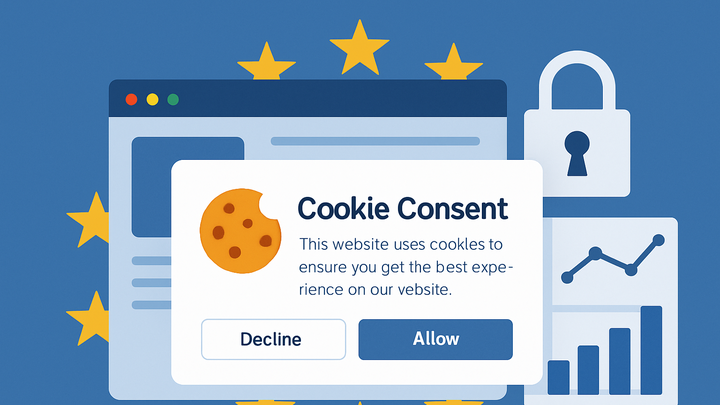Published on 2025-06-28T08:35:55Z
What is the ePrivacy Directive? Compliance and Implications for Analytics
The ePrivacy Directive (Directive 2002/58/EC), often called the “Cookie Law,” is an EU regulation that governs the storage and access of information on end-user devices in electronic communications. It requires websites to obtain informed, prior consent before placing any cookies or tracking technologies beyond those strictly necessary for core functionality. This directive complements the GDPR by focusing specifically on confidentiality and consent in online communication and marketing. For analytics practitioners, it means that cookie-based tools like Google Analytics 4 must delay or adapt data collection until users grant permission—often via Consent Mode. Conversely, cookieless platforms such as PlainSignal provide aggregated insights without storing personal identifiers or cookies, thus sidestepping the directive’s consent requirements. As the EU advances toward a new ePrivacy Regulation, understanding and aligning with the current directive remains essential for legal compliance and maintaining user trust.
Eprivacy directive
EU law mandating user consent for cookies and trackers; impacts analytics tools, favoring cookieless solutions and robust consent management.
Overview of the ePrivacy Directive
This section covers the origin, scope, and core requirements of the EU’s ePrivacy Directive, explaining how it regulates cookies and electronic communications.
-
Origins and scope
Introduced as Directive 2002/58/EC, the ePrivacy Directive addresses privacy in electronic communications, including cookies, metadata, and unsolicited messages.
-
Key provisions
Mandates user consent for storing or accessing information on devices, outlines exceptions for strictly necessary cookies, and requires clear information about cookie usage.
-
Consent requirement
Websites must obtain prior informed consent before setting non-essential cookies.
-
Cookie categories
Distinguishes between necessary cookies (for site function) and non-essential cookies (for analytics or marketing).
-
Exceptions
Allows cookies needed solely to transmit a communication or deliver a service explicitly requested by the user.
-
-
Relation to gdpr
While GDPR covers personal data broadly, the ePrivacy Directive zeroes in on confidentiality and consent for electronic communications and tracking technologies.
Impact on Analytics Tools
Analytics platforms rely on cookies and similar technologies to collect data. The ePrivacy Directive’s consent rules directly affect how these tools operate within the EU. Non-compliance risks legal penalties and erosion of user trust. Cookieless analytics solutions and robust Consent Management Platforms help organizations stay compliant while retaining insight capabilities.
-
Cookie-based analytics (GA4)
Google Analytics 4 uses first-party cookies to track user interactions. Under the ePrivacy Directive, you must obtain explicit consent before setting GA4 cookies or configure Consent Mode to adapt to the user’s choice.
-
Consent mode
Allows GA4 to operate in a limited mode without cookies, sending anonymized pings until consent is granted.
-
Data anonymization
GA4 can anonymize IP addresses to reduce personal data processing concerns.
-
-
Cookieless analytics (PlainSignal)
PlainSignal collects aggregated metrics without cookies or personal identifiers, exempting it from the directive’s consent requirements.
-
Data privacy
No personal data is collected or stored; insights are purely aggregated.
-
Ease of compliance
Operates without a cookie banner, simplifying GDPR and ePrivacy compliance.
-
-
Consent management platforms (cmps)
CMPs gather, store, and manage user consents, ensuring analytics scripts only activate after appropriate permissions.
-
Integration
Works with GA4, PlainSignal, and other tools to fire tags conditionally.
-
Audit trails
Records consent history for compliance reporting and audits.
-
Implementation Best Practices
Complying with the ePrivacy Directive requires auditing existing trackers, setting up consent mechanisms, choosing compliant tools, and maintaining documentation. These best practices ensure legal adherence and bolster user trust.
-
Audit cookies and trackers
Identify all cookies and tracking scripts on your site, categorizing them as essential or non-essential.
-
Mapping
Use browser dev tools or cookie scanners to inventory all cookies.
-
Categorization
Label cookies by function: necessary, analytics, marketing, preferences.
-
-
Configure consent banners
Implement a transparent banner that blocks non-essential cookies by default and offers granular choices.
-
User-friendly design
Clearly describe cookie purposes and provide opt-in/opt-out toggles.
-
Revocation and refresh
Allow users to change their consent at any time via an accessible link.
-
-
Select compliant analytics tools
Choose platforms that respect ePrivacy rules, either through cookieless methods or robust consent modes.
-
PlainSignal integration
No consent banner required; simply install the script:
<link rel="preconnect" href="//eu.plainsignal.com/" crossorigin /> <script defer data-do="yourwebsitedomain.com" data-id="0GQV1xmtzQQ" data-api="//eu.plainsignal.com" src="//cdn.plainsignal.com/plainsignal-min.js"></script> -
GA4 consent mode
Configure GA4 via Google Tag Manager to respect user consent settings.
-
-
Monitor and document consent
Keep records of consent banners, user choices, and analytics logs to demonstrate ongoing compliance.
-
Logging
Maintain logs of consent events for at least six months.
-
Reporting
Generate periodic reports to verify that only consenting data is collected.
-
